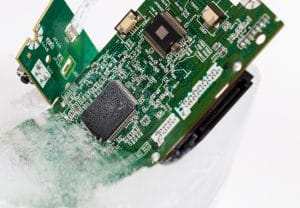 Heat exchangers have become a significant part of thermal management processes across multiple different industries. That includes everything from electrical cooling, or the process of removing waste heat from inside of an electrical enclosure, to more challenging thermal processes such as wastewater treatment, and more. In some cases, the reason heat exchangers have become so popular is because they make ultimate use of ambient cooling techniques. However, in applications where ambient cooling isn’t enough, heat exchangers are becoming just as popular for their below-ambient thermal management capabilities.
Heat exchangers have become a significant part of thermal management processes across multiple different industries. That includes everything from electrical cooling, or the process of removing waste heat from inside of an electrical enclosure, to more challenging thermal processes such as wastewater treatment, and more. In some cases, the reason heat exchangers have become so popular is because they make ultimate use of ambient cooling techniques. However, in applications where ambient cooling isn’t enough, heat exchangers are becoming just as popular for their below-ambient thermal management capabilities.
The limitations of ambient electrical cooling
In the realm of electrical thermal management, ambient cooling means to keep the temperature inside of an electrical enclosure at just above the ambient temperature outside of it. In many different applications, the maximum operating temperature is well above the ambient temperature, making this an effective as well as highly efficient method. However, for some modern applications, ambient cooling doesn’t achieve low enough temperatures to match the system’s operating parameters. For some companies, this may make it seem like traditional HVAC solutions are still necessary. Yet, modern heat exchangers can often provide the below-ambient cooling solution they need at much lower costs.
How heat exchangers achieve below-ambient cooling
Heat exchangers achieve electrical cooling in natural and eco-friendly ways, such as natural/forced convection, conduction, and/or phase-change cooling. Each of these methods is designed to transfer waste heat from one place to another, making them able to prevent electrical overheating without more costly and cumbersome air-chilling methods. Depending on the specific design of the heat exchanger (i.e., cold plate or heat pipe) and the eco-friendly cooling fluid it uses (usually water), heat transfer methods can also be utilized to keep temperatures within an enclosure at specific, below-ambient temperatures.
The advantages of below-ambient heat exchangers
When companies use heat exchangers for any thermal management processes, the benefits are often company-wide. Heat exchangers utilize less energy than traditional cooling methods, which means they can help lower a company’s energy expenditures and environmental footprint. Companies that rely heavily on applications that need below-ambient cooling can also benefit greatly by utilizing specialized heat exchangers to accomplish it. The more thermal management processes a company can dedicate to heat exchangers, the greater its overall savings will be, and the more efficient its overall operations can become.
For more information about how heat exchangers reach below-ambient cooling without chilled air, call Noren Thermal Solutions in Taylor, TX, at 866-936-6736.







